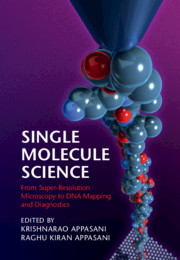Book contents
- Single-Molecule Science
- Single-Molecule Science
- Copyright page
- Dedication
- Contents
- Contributors
- Foreword
- Preface
- Part I Super-Resolution Microscopy and Molecular Imaging Techniques to Probe Biology
- Part II Protein Folding, Structure, Confirmation, and Dynamics
- Part III Mapping DNA Molecules at the Single-Molecule Level
- Part IV Single-Molecule Biology to Study Gene Expression
- 9 Single-Molecule Detection in the Study of Gene Expression
- Index
- References
9 - Single-Molecule Detection in the Study of Gene Expression
from Part IV - Single-Molecule Biology to Study Gene Expression
Published online by Cambridge University Press: 05 May 2022
- Single-Molecule Science
- Single-Molecule Science
- Copyright page
- Dedication
- Contents
- Contributors
- Foreword
- Preface
- Part I Super-Resolution Microscopy and Molecular Imaging Techniques to Probe Biology
- Part II Protein Folding, Structure, Confirmation, and Dynamics
- Part III Mapping DNA Molecules at the Single-Molecule Level
- Part IV Single-Molecule Biology to Study Gene Expression
- 9 Single-Molecule Detection in the Study of Gene Expression
- Index
- References
Summary
Determining rules for gene expression regulation is an important step toward predicting how cells are decoding the genome sequence to create a wide variety of phenotypes. Recent advances in imaging technologies revealed the stochastic nature of gene expression, in which different numbers of mRNA and protein molecules can be created in cells that have the same genome sequence (Elowitz, 2002); Kaufmann and van Oudenaarden, 2007). An early research revealed that this stochasticity is yielded by two factors: intrinsic and extrinsic noise. While the former is due to instant random chemical reactions in gene expression process, the latter is caused by cell specific molecular states emerging from the integration of gene expression over a longer time (Elowitz, 2002); Kaufmann and van Oudenaarden 2007). This finding inspired studies to investigate how cells deterministically cause robust phenotypes under such stochasticity. In contrast, this also motivated investigations on how cells utilize this stochasticity to generate different kinds of phenotypes for processes such as neural development (Johnson et al., 2015), emergence of bacterial resistance (Sánchez-Romero and Casadesús, 2014), or cancer development (Marusyk et al., 2012; Junttila and de Sauvage, 2013).
- Type
- Chapter
- Information
- Single-Molecule ScienceFrom Super-Resolution Microscopy to DNA Mapping and Diagnostics, pp. 127 - 141Publisher: Cambridge University PressPrint publication year: 2022

